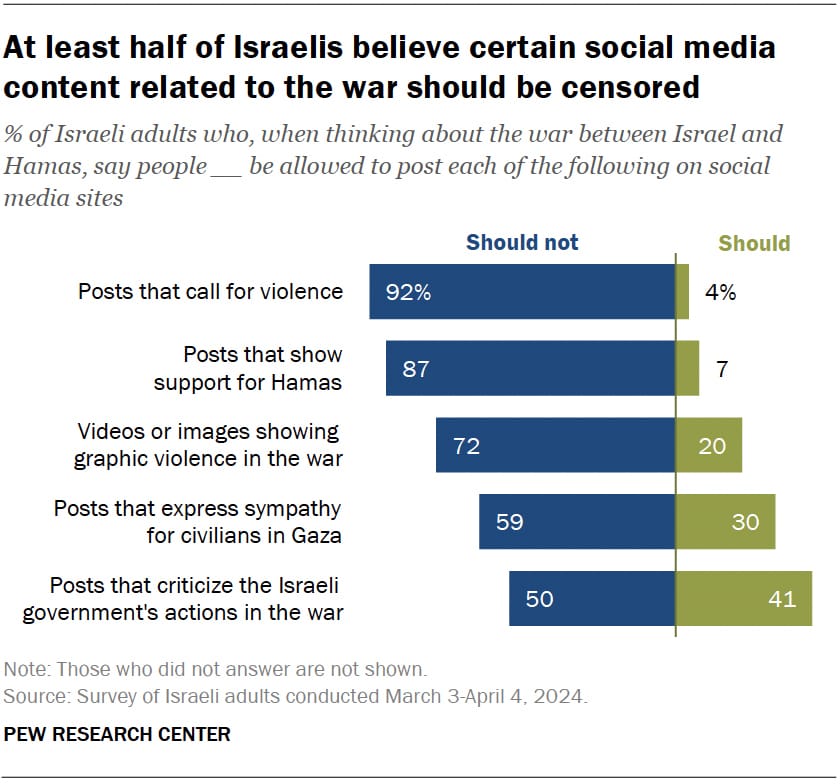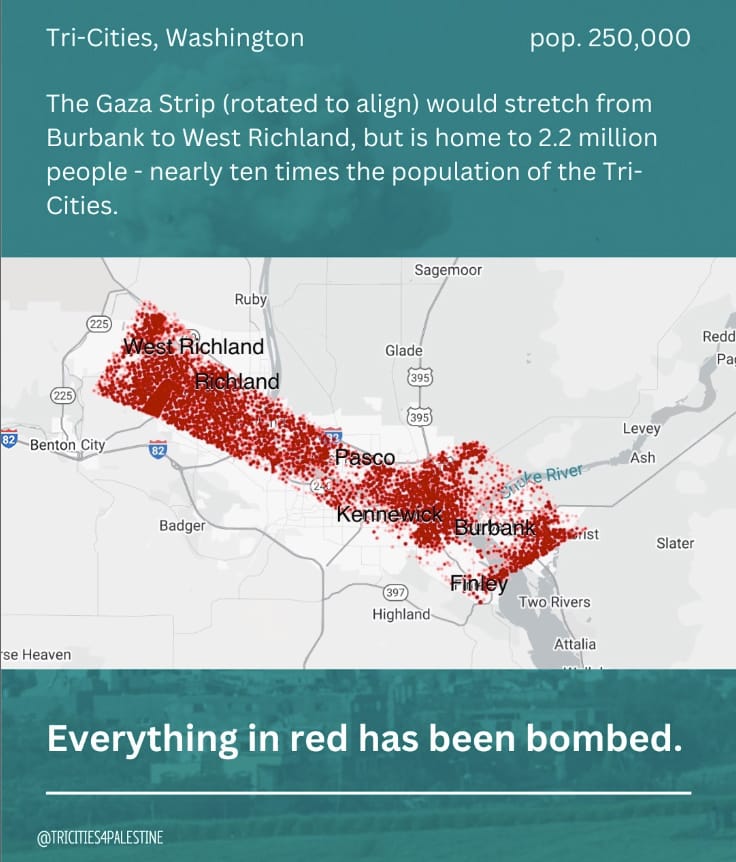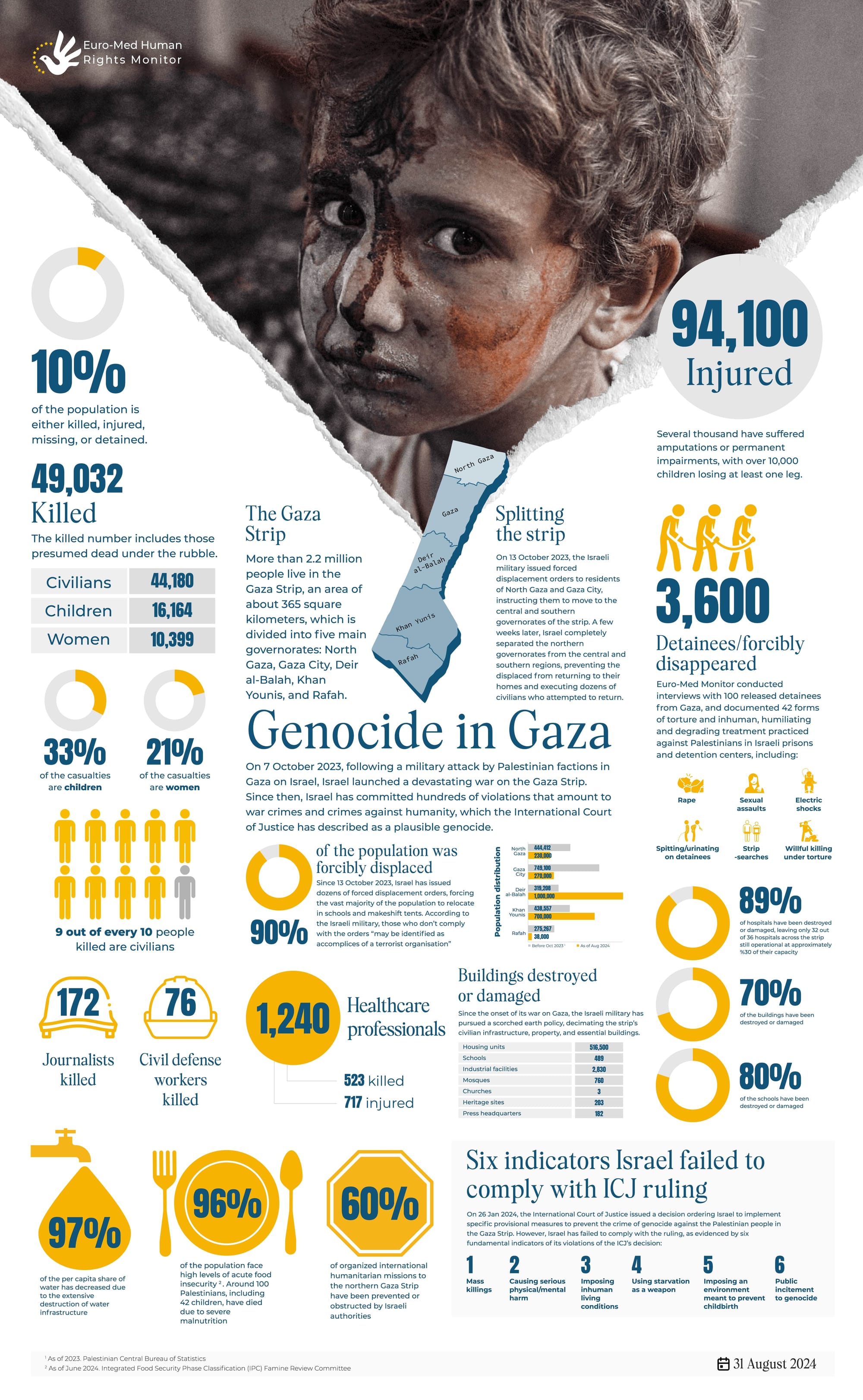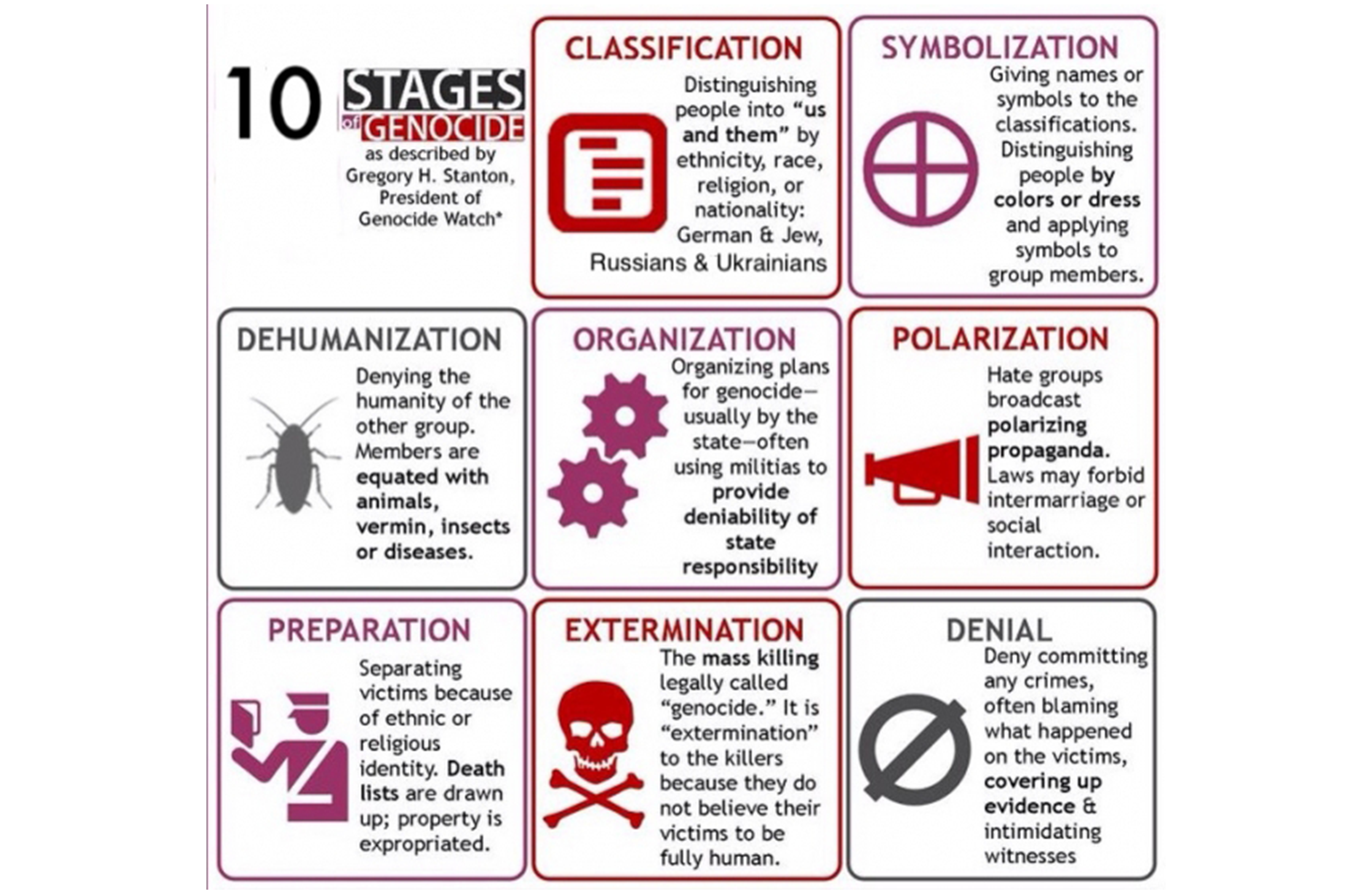“Education is not memorizing that Hitler killed six million Jews. Education is understanding how millions of ordinary Germans were convinced that it was required.” — Noam Chomsky
“Ten Stages of Genocide” is a formula developed by Dr. Gregory Stanton, Vice President of the International Association of Genocide Scholars, for how society engages in genocide. Genocide cannot be committed by an individual or small group; rather, it takes the cooperation of a large number of people and the cooperation of the state. By knowing the stages of genocide, citizens are better equipped to identify the warning signs and stop the process from beginning and continuing.
The ten stages of genocide are: classification, symbolization, discrimination, dehumanization, organization, polarization, preparation, persecution, extermination, and denial.
The following examples are some of the ways that these stages are being enacted by the state of Israel on the Palestinian people.
STAGE ONE: CLASSIFICATION
People divided into “us and them”
Several UN special rapporteurs, states, and human rights organizations have recognized Israel’s policy of oppression, segregation, and discrimination by ethnicity as apartheid. The International Court of Justice gave an advisory opinion in July recognizing this system as the crime of apartheid.
STAGE TWO: SYMBOLIZATION
People forced to identify themselves
A color-coded ID card system identifies Palestinians and restricts where they can live, their freedom of movement, access to services, and voting rights. Everyone born in Israel, the West Bank (including East Jerusalem), and Gaza receives an ID card from the Israeli Ministry of the Interior. The ID System is a tool of population control that maintains Israel's apartheid policies of fragmenting the Palestinian people into different legal, geographic, and political domains, each with different rights, and denying Palestinian refugees the right of return. This animation by Visualizing Palestine explains the different colors and how they impact each group of people: visualizingpalestine.org/visual/israeli-id-system-animation
STAGE THREE: DISCRIMINATION
People begin to face systematic discrimination
Palestinians are viewed as an undesirable element and treated as inferior citizens or ‘security threats’. To commemorate 30 years of operation in 2019, Israeli human rights organization B’Tselem released a moving report entitled “Just The Tip of the Iceberg: One Victim a Year Times 30 Years”. In this report, B’Tselem tells the story of a single instance from 1989 to 2019 of the many thousands of Palestinians killed, beaten, or wounded by Israeli soldiers and covered up by military police. They then go on to write, “The violence and its whitewashing are the double helix that make up the occupation’s DNA. The two are closely intertwined: without state violence, as carried out by its security forces, a people cannot be oppressed and its life regimented and controlled. But without whitewashing, the security forces would refuse to employ violence. This, then, is the awful pact between government control and ‘security’, a deal without which there could be no occupation or control.”
STAGE FOUR: DEHUMANIZATION
People equated with animals, vermin, or diseases
Israeli government officials have publicly referred to Palestinians as “monsters”, “human animals”, “barbaric”, “subhuman”, and “premodern”. Soldiers have called Palestinians “terrorists”, “roaches”, and “rats” on social media. In February, Law for Palestine released a database of 500 documented instances of incitement to genocide by Israeli government leaders and soldiers.
STAGE FIVE: ORGANIZATION
The government creates specific groups to enforce policies
Under the Oslo Accords of 1995, the West Bank was divided into three legal areas. Densely populated Palestinian areas were designated Areas A and B, constituting 165 disconnected ‘islands’. On paper, these areas are under the full or partial control of the Palestinian Authority. In practice, Israel’s Coordinator of Government Activities in the Territories (COGAT) is the de facto ruler of the occupied territories. Every part of daily life — from obtaining construction permits, government IDs, and travel from one area to another — is controlled by COGAT. Military checkpoints and temporary or permanent roadblocks restrict the movement of Palestinians.
Military courts, according to B’Tselem, “serve as one of the central systems maintaining its control over the Palestinian people.” Palestinians of all ages, including children, are tried and prosecuted in military courts and prisons, where they are often held without charge under administration detention for 6-month periods that can be renewed indefinitely. Defense for Children International describes these military courts’ “systematic denial of fair trial rights” as “arbitrary detention.”
STAGE SIX: POLARIZATION
The government broadcasts propaganda to turn the populace against the group
‘Hasbara’ is a public diplomacy technique used by Israel to cultivate a positive public image by controlling the information presented to viewers. Hasbara is so effective that polling in November 2023 found that 57.5% of Jewish Israelis believed that the IDF was using too little firepower in Gaza. In Jan 2024, the Peace Index found “an absolute majority (88%) also justifies the scope of casualties on the Palestinian side when considering the goals of the war.” In February, 68% of Jewish Israelis said they oppose the transfer of humanitarian aid into Gaza by organizations that are not affiliated with Hamas or UNRWA. Most recently, at the end of August, Pew Research found that at least half of Israelis believe that social media posts that criticize the Israeli government’s actions in the war and posts that express sympathy for civilians in Gaza should be censored.

STAGE SEVEN: PREPARATION
Official action to remove/relocate people
In the 1948 Nakba, 750,000 Palestinians were forced out of their homes and into what Israeli historian Ilan Pappé calls the “open-air prison” of the West Bank and the “maximum security prison” of Gaza. Since then, forced relocation of Palestinians has continued with expanding illegal Jewish settlements in the West Bank. Today there are approximately 2.2 million residents in the Gaza Strip, hemmed into an area about the size of the Tri-Cities.

STAGE EIGHT: PERSECUTION
Murders, theft of property, and trial massacres
For the past two decades, Israel has had a policy it calls “mowing the lawn” in Gaza, periodically bombing the captive population in attempts to keep down resistance, followed by periods of ‘calm’ where survivors are left to clear the rubble and bury the dead. At the same time, settlers in the West Bank have harassed Palestinian families, carrying out pogroms against them, and have destroyed or taken over their homes. The international community has for decades looked the other way, giving tacit permission to Israel to escalate to the ninth step of genocide.
STAGE NINE: EXTERMINATION
Wholesale elimination of the group (called “extermination” and not murder, because the people are not considered human)
On October 9th, Defense Minister Yoav Gallant stated, “There will be no electricity, no food, no water, no fuel, everything is closed. We are fighting human animals and we will act accordingly.” His sentiments have been echoed by countless Israeli ministers and media. In early September of this year, two Israelis hosting an English language podcast claimed that every Israeli would agree that, “If you gave me a button to just erase Gaza, every single living being in Gaza would no longer be living tomorrow. I would press it in a second.”

These are not just fantasies of extermination, but have become the reality on the ground. According to Euro-Med Monitor, as of August 31, the Israeli army has killed at least 44,180 Palestinian civilians in Gaza, including 16,164 children. This doesn’t include the thousands who are still stuck under the rubble, are missing and are presumed dead, or have died from secondary causes like disease and famine. The real death toll has been conservatively estimated at 186,000 as of mid-June and, if left unchecked, by the end of the year could be as high as 335,500 — more than 10% of the Gazan population and approximately equal to the entire Tri-Cities metropolitan area population.
STAGE TEN: DENIAL
The final step in genocide: The government denies that is has committed any crime
The Israeli government and allies, including the U.S, deny their war crimes, even though all major human rights organizations, many UN special rapporteurs — including the rapporteur on the Right to Food, Palestinian Territories, the Human Rights Council, and dozens of other UN experts — and hundreds of genocide scholars (see contendingmodernities.nd.edu/global-currents/statement-of-scholars-7-october and https://www.mezan.org/public/en/post/46295), and genocide prevention institutions have all recognized Israel’s current action as genocide.
…
Violence begets violence. The only way to stop the cycle of violence is to recognize that the security of neighbors is intertwined. As James Baldwin explained, “We've yet to understand that if I'm starving, you're in danger. When people think that my danger makes them safe, they’re in trouble.” Mutual flourishing is the only path forward for both Palestinians and Israelis.
There is no military solution. Guns and bombs will not bring freedom or safety for either Palestinians or Israelis. There is no safety in occupation and apartheid. We need a long-term diplomatic solution to address the root causes of violence.
Beyond the genocide of Palestinians, without a ceasefire, the life of every Israeli hostage in Gaza is at risk each day. I echo the calls of their families in Israel: Everyone for everyone. We need a hostage exchange now. Our humanities are interwoven together.
Not only is the security of Palestinians and Israelis bound together with one another, but our security as Americans is also bound up with theirs. The violence and hatred that our government funds and our media promotes abroad returns to us in many forms, including Islamophobia and antisemitism. Our Jewish, Muslim, Arab, and Sikh neighbors and friends deserve safety and security wherever they live. Islamophobia and antisemitism ought to have no place in our communities, but we have seen them on the rise in this country over the past year. Our commitment to ending genocide through peacemaking ought to compel us not only to demand a ceasefire, but to also root out violent theologies and ideologies that promote antisemitism and Islamophobia.
There is an ongoing genocide in Palestine, yet, there is still hope. According to Dr. Stanton, who studied these stages, “Genocide is a process that develops in ten stages that are predictable, but not inexorable. At each stage, preventive measures can stop it.”
Vikan Attarian, third generation survivor of the Armenian genocide, observed: “Genocide recognition does not necessarily begin at the state level; it starts with individuals [emphasis added], followed by communities and states; and then, ideally, there is acknowledgement by the perpetrators.” At a summit on healing for survivors, he urged his audience to “stare evil down” as a collective group of citizens and build bridges among communities of genocide survivors and allies to enact preventive measures.
Genocide can be prevented through the international collaboration of ordinary people as peacemakers, according to the Lemkin Institute for Genocide Prevention. Genocide prevention must be a tool for and from the grassroots.
Perhaps, like me, you grew up hearing, watching, and reading stories about the Holocaust and asking yourself what you would have done if you were in that situation. That is why I cannot be silent in the face of a genocide perpetrated by my own government. And that is why I joined a small group of like-minded people to start Tri-Cities for Palestine.
Tri-Cities for Palestine is a community-based group that is focused primarily on the rights and liberation of the people of Palestine. We promote the goal of divestment by all institutions and governing bodies from the state of Israel as it continues its genocidal campaign against the people of Palestine. We believe the only possible way to bring peace to the citizens of Palestine and Israel is to call for a permanent ceasefire, leading to the release of hostages, and ending the violence against civilians.
Israel is an apartheid state, and that oppressive system of government must be dismantled in order to make any social progress. We do not promote violence, antisemitism, or bigotry of any form. The dissolution of an oppressive government is not a call for violence, it is a call to dismantle a government that has dehumanized a group of people for nearly a century. Beyond this, we disavow all forms of colonialism and neocolonialism, from Palestine to Sudan, Congo, Tigray, Haiti, and the United States.
We hold weekly Rallies for Arms Embargo and Ceasefire on Saturdays from 2–4pm.
Check our Instagram or Facebook @tricities4palestine for the location.
We are also holding an Interfaith Memorial Service to commemorate the one-year anniversary of the current genocide in Gaza. Please join us on Sunday, October 6 from 6:30–8:00pm at The Fingernail in Howard Amon Park to mourn the lives lost and renew hope together.
It is never too late to do the right thing. As Maya Angelou encourages us, “When you know better, do better.” Hold onto the belief that change is possible both for individuals and for systems, and join our grassroots peacemaking movement to end the genocide and promote liberation.
A long-time Tri-Cities resident, Amber Bruce is a co-founder of Tri-Cities for Palestine, a community-based group dedicated to the liberation of Palestine.
Instagram: @tricities4palestine

